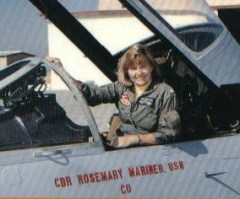
University of Tennessee
I received an email from a doctoral student at the University of West Florida who is writing her dissertation on women military careerists born between 1940 and 1955. As a result, she has spent a good amount of time talking to retired service women, as well as visiting the National Naval Aviation Museum in Pensacola, Florida. She asked me: “Where are the women aviators?”
The Naval Air Station in Pensacola has been the main training ground for naval aviators since 1914. Therefore, it’s also the place where the first woman naval aviators were trained in the 1970s. I have not been there, but apparently the fact that there are women in naval aviation gets scant attention at the museum.
There is, however, an online-only timeline that lists some of the accomplishments of women, starting in the 1980s. Based on its website, the museum itself seems to highlight the accomplishments of men during the World Wars, Korea, and Vietnam, when women were not present (except as housewives saving bacon grease, or a sailor flirting with a “girl” at a movie ticket counter…really!). It also has an exhibit on the planes (of course), naval aviation in space, on Bob Hope, Coast Guard aviation, and airships.
I am not a fan of highlighting women only in exhibits, but the museum’s focus appears to be on things that women have had limited participation in. I’d like to see photos of naval women interspersed within the exhibits on World War II where they served as instructors, air traffic controllers, flight nurses, mechanics, and other support personnel. There have also been women astronauts like Kathleen Sullivan, a naval reserve oceanography officer, who was the first American woman to walk in space. She flew on three space shuttle missions and logged 532 hours in space.
Here are a few facts that perhaps would give girls who visit the museum with their families some role models and help to incite some dreams of their own:
— In 1973, Lieutenants Victoria Voge and Jane McWilliams became the Navy’s first two women flight surgeons.
— Also in 1973, six women became the first to win their wings and be designated naval aviators. They were: Judith Neuffer, Barbara Allen Rainey, Rosemary Conatser Mariner, Jane Skiles O’Dea, Anna Scott Fuqua, and JoEllen Drag Oslund. Allen Rainey was the first to named and all six were the first women pilots in any of the armed forces. Two went into helicopters, four into fixed wing, multiengine aircraft. All planes were considered “non-combatant.”
— By 1974, Barbara Allen Rainey became the first Navy woman to qualify as a jet pilot. Unfortunately she was also the first woman aviator to be killed during a “routine” flight in 1982.
— In 1976, for the first time women entered naval aviation via Aviation Officer Candidate School vice the non-specialized Officer Candidate School in Newport, R.I.
— In 1983, Commander Colleen Nevious became the first woman pilot to graduate from the Navy’s Test Pilot School.
— In 1990, Rosemary Mariner became the first woman to command an aircraft squadron. By 1992 women aviators were still uncommon, with only 1.5% of the Navy’s pilots and Naval Flight Officers.
— By 1993, the Navy’s combat units were open to women AND they were able to fly combat missions.
— In 1994, women were first assigned to aircraft carriers, the USS Eisenhower and the USS Lincoln.
— In 2004, Wendy Carpenter became the Navy’s first female aviator admiral.
There are many others, and I’m not saying the museum is anti-women, but it is surprising that little about these capable, brave, and awesome women appears in the Navy’s foremost aviation museum. That needs to change.


